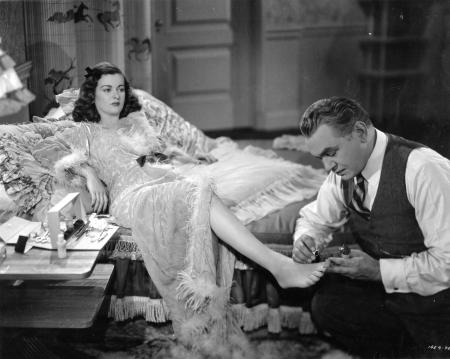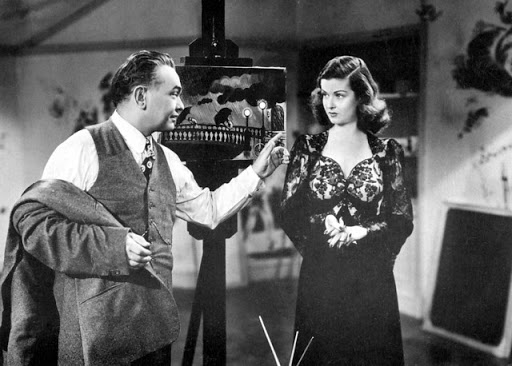One of my classes this semester is on Film Noir, so I get to watch a lot of films depicting the postwar trauma through rainy streets, shadows, and femme fatales. I saw Fritz Lang’s Scarlet Street last week, and is now one of my favorite film noirs. You can watch the film here, and come back to discuss it with me!
Edward G. Robinson is starring in the film as the ordinary man who is lured into trouble by Kitty (Joan Bennett), a charming femme fatale. Kitty enters the man’s life, and she and her boyfriend Johnny take full advantage of his vulnerability until he is completely destroyed. Welcome to life in noir!
It is very interesting to see the details the filmmaker uses to indicate there is something off with the main character. In the 1940s US, “being a real man” has some rules and boundaries one needs to comply with, and the main character in Scarlet Street doesn’t fall within them.
His name Chris Cross creates the imagery of a huge X on the character for me. It reminds me of cross-dressing or transgenderism, as well. He is very effeminate; he not only washes the dishes after his wife orders him to, but he wears his ruffled apron, too. He applies nail polish on Kitty’s feet and dreams about taking her surname when they get married. It’s funny to see the economic use of stereotypically feminine stuff to downgrade a character.
On the other hand, Johnny is basically pimping Kitty. How come that’s more manly?

Portraits and paintings generally hold great importance in film noir. There are power-related ideas behind it and a fascination far from reality but based mostly on imagination and an ideal representation. Accordingly, the portraits are usually realistic paintings of powerful figures. In contrast, if the painting is more abstract, it suggests that the painter is perverse, mentally ill, or degenerate. So, Chris’ abstract-ish artwork would be considered very cool today, but it means he is not a real man, then.
Portraits also refer to the past living in the present. Remember that Chris’ wife’s ex-husband’s huge picture is hanging on their wall. It is a realistic painting of a “real” man. The husband keeps his presence and dominates Chris with his piercing look.
Remember the haunting scene. While the feeling of guilt doesn’t let Chris be, Kitty’s voice calls “Johnny.” Still, he is tormented by being reminded of a man that he is not. Meanwhile, lights are turned on and off in his apartment. This is a significant detail to notice because it is related to how we should perceive the film. Either Kitty is really haunting him, and this is a magic realist film. Or, we see his screwed up emotions and guilty psyche through cinematography, so Fritz Lang is greeting his German Expressionist roots.
Chris Cross is the average man who is played by the system, his wife, and Kitty. He wants to rank up in the system because powerful men get away with anything they do. The corruption within the American system is hinted at when the policemen accept cigars as a bribe, as well. Nevertheless, Chris cannot get away with it because of the guilt that consumes him from inside.
The film makes me think that it hates its main character in every aspect from the beginning to the end. Comment below and let me know what you thought about it!
